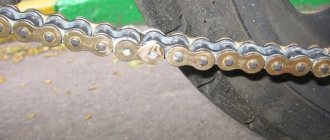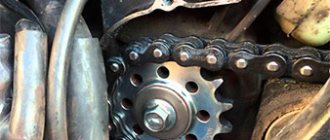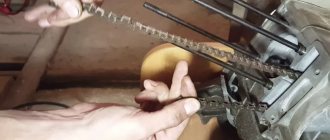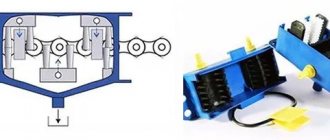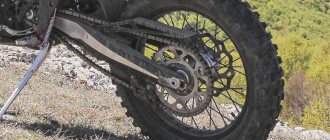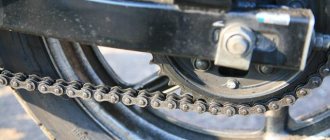I must say right away that the chain drive itself has been known for a long time; now it is not the only option, but it is still popular to this day. Its main advantages are ease of installation and maintenance, high efficiency, affordable price, and the ability to change the so-called without unnecessary hassle. gear ratio. There are also disadvantages, of course. The main disadvantage is that the chain stretches, wears out and therefore sag - you have to tighten it. And it needs to be lubricated regularly.
Each motorcycle chain of a decent brand has a proprietary index that can immediately answer a number of questions for an informed buyer. Thus, the most widespread products are those with indices 428, 520, 525 and 530. The first number in them is the chain pitch (the distance between the axes of the link fastenings), and the next two are the width (exactly the internal width where the teeth go).
No tightening or loosening should be done to compensate for extra or missing links. When buying a replacement chain, most motorcycle owners take their old one and count how many links there are, and then look for an analogue. There is an option to change the gear ratio and/or drive sprocket, then the number of links will have to be increased/decreased.
According to the type of seal, all motorcycle chains are divided into sealed and sealless. Actually, the name eloquently indicates the features of the device. The stuffing box type is marked according to the type of seal: O-ring, X-ring, W- or Z-ring. The index indicates the service life and friction losses. The oil seals keep the lubricant in the rollers, reducing wear, which greatly increases the life of the entire chain. Naturally, you need to lubricate a motorcycle chain with a compound specially designed for this purpose, and not with any lubricant.
There are several types of oil seals, they differ primarily in their cross-section. At one time, it was thanks to oil seals that the need for protective covers disappeared and the open system gained popularity - now almost all motorcycles are like this. And sealless chains have become niche - they are popular in sports and for models with small cubic capacity.
Locks and sizes
As a rule, locks come complete with chains, less often they are bought separately where they are sold. But by default, they are not meant as safety features, like for bicycles, but rather as connecting locks. You can buy a lock separately, according to the chain marking - the index must match. Different locks differ from each other mainly in the thickness of the plates and pins, as well as in the materials used, so it is highly recommended not to experiment, but to use a lock from the same manufacturer and with the same index for your chain.
As a rule, when choosing a chain, they are guided not only by basic technical parameters, but also take into account the operating conditions of the motorcycle. For example, for powerful sports models with a liter volume by default, a reinforced chain will be needed. It is more expensive than usual, but will withstand working with an engine of a couple of hundred horses. But for a road motorcycle, there is no point in buying the most expensive chain in a car store.
What are seals and why are they needed?
Oil seals are rubber seals between the “cheeks” of the chain.
The oil seals are shown in red in the figure.
In off-road use, the drive chain operates under very difficult conditions. Sand, water, dirt - all this gets inside the chain, washes away the lubricant, acts as an abrasive and accelerates chain wear. So, oil seals protect the chain from all these unfavorable factors and retain lubrication inside the chain, thereby extending its service life!
Stuffed chains have a much longer service life than sealless chains. And the more severe the conditions the chain operates in, the more noticeable this difference is. If you often find yourself in a swamp, cross fords, or like to storm hills in sand quarries, then an oil seal chain is your choice!
According to our observations, sealed chains last at least two and sometimes three times longer than sealless chains.
As you know, every coin has two sides, and every barrel of honey has a fly in the ointment.
Features of chains from EK Chain
The brand is considered the flagship of its field. It was this brand that first created the O-ring drive, and now offers a range of different types. And for several decades now, motorcycle chains produced by EK Chains have been considered among the highest quality.
The simplest option is considered the standard: a sealless chain for small-capacity motorcycles. Yes, it stretches quickly and requires frequent lubrication. And you need to clean it often. But friction losses are very small. And if you need a stronger analogue, you can purchase the so-called. high-load chain of the same brand. Made from more durable materials, suitable for motorcycles with a volume of up to 0.65 liters.
The O-Ring type O-ring chain of the SRO series is equipped with round seals to retain lubricant and protect friction pairs from dirt. As a result, the product life is half that of sealless ones. But there is also a minus: turning the links increases friction, which reduces power. Ideal for motorcycles with a volume of 0.75 liters.
X-shaped rings in the range of this brand are available in the QX-Ring and Quadra-X chains. There are ventilation holes to keep the chains cooler. And friction is 40% less, thanks to a smaller contact surface. And the seal is better. According to test results, chains with Quadra-X can last approximately half as long as O-Ring. The branded SRX2 series is recommended for motorcycles with a volume of up to 1 liter.
This brand also has products produced using Zero Stretch technology - labeled ZST. They are guaranteed not to stretch during the first thousand kilometers. Initially they were created to preserve the length of the chain for the entire period of operation.
It is also worth mentioning a couple of classes: MVXZ2 and ZVX3 The first of them are chains for powerful “iron horses” with a volume of 1-1.4 liters, and the second are chains with record tensile strength. For example, the original version of the 520ZVX3 holds 11,100 kg per hundred links, and weighs only 2.2 kg - it can be safely installed in any motorcycle used under heavy load.
What types of transmission are there on motorcycles?
At the moment, there are different types of transmissions for transmitting torque from the engine to the wheel besides a chain transmission? Initially, a cardan drive was created, characteristic of large and heavy motorcycles. If it is a heavy chopper or a Soviet Ural, then a cardan suits it. The cardan drive is similar, does not require frequent maintenance, is robust and durable. But it has serious disadvantages:
- Takes a lot of power. If you have a huge engine of more than 1 liter, then a small loss of power will not be noticeable. For light motorcycles, turning such a colossus is too expensive.
- It weighs a lot. It adds to the weight of the motorcycle, and on the one hand.
- Takes up a lot of space. Shaft, gearbox, where to place it all? Question.
There is also a belt drive, but this is rather rare and exotic. The belt looks like a regular car timing belt. Most often hidden behind a casing. It would seem like a good idea with a belt, but only until you drive off the perfectly clean asphalt. Any sand or dirt that gets under the casing can instantly damage the belt. Therefore, the belt is for rare motorcycles that ride exclusively on asphalt.
Motorcycle belt drive
As we can see, if we take into account the shortcomings of the cardan and belt drive, the chain is an ideal transmission for a motorcycle, even despite its shortcomings:
- Requires constant monitoring of tension and stretching
- Lubrication is required
- Limited resource
- The need to monitor the condition of the stars and replace them.
Chains also have a huge advantage: the ability to adjust torque by changing stars. If you need to go fast, you simply change the drive or driven sprocket and go faster with fewer engine revolutions.
DID brand chains
This Japanese brand is considered the most popular these days. The statement is controversial, but they buy a lot of branded chains. The products fully justify the reputation of Japanese products in terms of quality and cost; the range includes options for almost any type of motorcycle. They are widely used in sports and are often included as standard equipment on conveyor models.
The original marking consists of numbers and letters and is applied to the outside of the chain. First, the pitch and width are indicated there, and then the parameters and purpose. There are almost a dozen main models: DID VX, ZVMX, ERT2, MX, VT2, 520ER3, 520ATV, VO. The first of them is designed for sports and road bikes: X-Ring oil seals, a choice of colors - black or gold. The second is considered the most durable among all the chains of this brand; it is used on road and sports motorcycles. An expensive thing, but for the sake of mileage or for a powerful car it will be just right.
The sealless ERT2 is useful for off-road use. It has high strength and reliability, and a long service life. In motocross and enduro, many riders use this chain. And if you need record strength, for motocross or motards, you should pay attention to MX. In turn, VT2 is recommended for long-distance enduro travel - it is also used on ATVs.
Those who prefer lightweight racing chains will immediately stand out from the lineup with the 520ERV3, with X-Ring oil seals. The company's assortment includes a reinforced oil seal model specifically for ATVs, with a volume of up to 0.75 l - 520ATV. And a budget option is also presented: VO, for medium-power road bikes (volume up to 0.5 l) - an O-Ring chain, steel-colored, which has proven its reliability in practice.
Motorcycle chain tensioning
Tensioning a chain on a motorcycle can be time-consuming. Its adjustment is often not easy. It is necessary to ensure that each chain link is inserted into the sprocket.
First you need to match all the links with the so-called stars. The chain tension will be quite tight. However, this can be adjusted thanks to special mechanisms on the motorcycle. Almost every motorcyclist knows how to tension a chain on a motorcycle. There are many instructions for this purpose. If you find it difficult to understand them, then you can purchase a chain with a spring lock and easily install it on your motorcycle.
Table. Designation and application of motorcycle chains.
| Circuit designation | Where is it used? | Motorcycle model | Pitch, mm | Roller diameter, mm | Chain width, mm | Number of links, pcs. | Chain length, mm |
| 2PV-9,525-1800 | Motor transmission | “Izh-56”, “Izh-P1”, P2, P3, P4, Yu5, “Izh-Yu”, Yu2, Yu3, Yu4, Yu5 | 9,525 | 6,00 | 25,4 | 66 | — |
| PV-9,525-1200 | Same | M-105 MMVZ all models | 9,525 | 6,00 | 9,52 | 44 | 419,1 |
| PR-12.7-1820-2 | main gear | "Sunrise", "Java" | 12,7 | 8,5 | 7,75 | 112 126 | 1422,4 |
| PR-15.875-2300-2 | Same | Motorcycles, all “izhi” | 15,375 | 10,16 | 9,65 | 104 | 1651 |
What are SFR chains?
Chinese products, but of good quality. The assortment includes series made from Japanese components and metal, with the highest parameters. The company itself is relatively young - almost 30 years old (since 1991). Currently, over 1,200 thousand chains are produced under this brand every month: for motorcycles and elevators, timing belts, and industrial equipment. They are sold in Japan and Europe, in the USA.
Branded chains have already proven themselves to be durable and wear-resistant. All products comply with ISO standards, and each product undergoes tensile bench tests. The range includes sealed (various types) and non-sealed (solid core) versions. You can select a suitable chain according to the recommendations of the bike manufacturer and taking into account how it is used. With regular diagnostics and proper care, a chain of this brand will certainly work out its value.
O-SEAL CHAINS
These chains have small ring-shaped seals located between the pins and guide bushings. They hold the lubricant inside the rollers. Oil seals also protect the internal elements of the chain from various contaminants that cause accelerated wear. Without lubrication, the chain will wear out quickly. Oil seals are usually made of synthetic rubber (acrylonitrile-butadiene), which has good wear- and oil- and petrol-resistant properties.
Chains with O-rings create friction, which requires additional power to overcome. The seals are under pressure, so it takes more energy to move the chain. This is why the amount of transmitted power drops.
And finally about Tsubaki chains
The brand is represented by the Japanese company Tsubakimoto Chain Co. of the same name. Now it is known as the largest manufacturer of transmission systems; no one else produces them on the entire planet. This is a multinational organization with offices in many countries, but all 4 factories are located in Japan. The company catalog contains chains for industrial equipment and vehicles, for a couple of dozen industries. Incl. heavy-duty, low-noise, lubrication-free, plate, steel, etc.
In the motorcycle sector, Tsubaki is also the undisputed leader. This brand has its own classification of chains: either by power reserve or by durability. For example, products of the Gamma series are designed for a mileage of 5-10 thousand km, Alpha and Omega - from 10 to 20 thousand km, Alpha XRG and Sigma must withstand 20-30 thousand km.
Really good chains don’t just become world leaders. And the company will soon celebrate its centennial anniversary. Invests heavily in improving products, increasing the life of trouble-free operation, increasing productivity, and reducing the cost of products. The company catalog presents chain drives for any technical task - you just need to choose the optimal option. Experienced users can easily navigate themselves, while consultants help those less technically savvy with their choice. It is recommended to select a chain not just for the model, remotely, but for a specific motorcycle, taking into account all the circumstances - this is how the Tsubaki branded chain drive will show itself in the most favorable light.
Features of the design and application of stuffing box chains
Any development and progress brings with it the emergence of additional types and variations and, depending on the purpose, both old and new types, processes, and equipment are used. This is the norm of any development. It is only important to correctly use the available opportunities. This statement also applies to such a problem as choosing a drive chain, this is especially true when choosing a chain for a motorcycle and other motor vehicles.
What is an oil seal and why is it needed?
The oil seal has been used as an integral part of the design of units in technology for a long time, but it began to be used in the design of roller chains relatively recently.
An oil seal (in engineering) is a special seal in an assembly used to seal gaps, including between moving elements, and to retain liquid (lubricant) in the cavity.
Nowadays, it is more correct to use the expression “oil seal”, and the word “oil seal” is rather a jargon, preserved from the times when an oil seal was called flax or jute hemp soaked in fat, which was used to seal gaps.
Currently, other materials are used in industry as gland seals, including oil sealing rings.
Stuffing box chain design
In one of our articles we looked at the design of a roller chain (see “Dimensions of a drive roller chain and its design”). Let's briefly repeat:
- the roller chain consists of internal and external links, which, respectively, have internal and external plates;
- the internal and external links are connected by means of a roller and a bushing (the roller is fixed in the outer plates, and the bushing in the inner);
- roller - a rotating element that contacts the sprockets and reduces the load on the bushing.
Thus, when operating a standard roller chain, the main loss of efficiency and wear of chain parts occurs:
- when the sleeve rubs against the roller,
- during friction between the plates,
- when the roller and bushing rub.
To prevent (reduce) friction, chain lubrication is used, which should be carried out periodically to increase the service life of the chain.
concept of the stuffing box chain is to prevent lubricant from leaking out of the cavity between the two main contacting elements: the roller and the bushing. Lubricant is pumped between the roller and bushing at the factory when the chain is assembled. is placed between the inner and outer plates - an oil sealing ring . As a result, the contact between the outer and inner plates is reduced.
The result of this approach and chain design is an increase in its service life.
MY MOTORCYCLE
Chain transmission has long been firmly established in the motorcycle world. In the vast majority of cases, the drive wheel is driven by a classic single-row chain. Here is an incomplete list of the advantages of such a drive: ease of use with a classic motorcycle layout, low cost, reliability, ease of operation. The only negatives, perhaps, are the noise and the need for regular maintenance. The latter has been haunting designers, mechanics and, in fact, motorcyclists themselves for hundreds of years. Nobody wants to constantly deal with a dirty, dirty and foul-smelling chain. However, over the same hundred years, fundamental changes have not occurred. How to properly handle this transmission element?
Here are excerpts from the instruction manual:
- Dirt, dust and insufficient lubrication will greatly reduce the life of the chain.
- Clean and lubricate the chain regularly.
- The chain should be lubricated after every 1000 km. After riding in wet weather or in very muddy or dusty conditions, lubrication should be done more frequently.
- Clean the chain with a suitable product, let it dry and apply lubricant.
• Wipe off excess.
I think it is clear to all residents of our country that any driving is associated with either wet weather or conditions of severe dirt or dust. And more often with both. Obviously, to comply with factory recommendations, the chain will have to be cleaned and lubricated at least once every 500 - 700 km. And also after every pressure wash. By the way, such a motorcycle wash is not very useful. After all, diligent washers, without going into details of the design, diligently wash out not only chain lubricant from the joints of the links. It affects the wheel seals, the radiator, and electrical connectors. And the following trouble can happen to the chain - a powerful jet of water that accidentally hits it, say, when trying to wash a wheel rim or pendulum, washes out the lubricant, but not from the entire chain, but only from part of it.
As a result, it is in this area that additional friction and increased wear occur.
But there is nothing worse than an unevenly worn chain! Manufacturers of motorcycle cosmetics decided for us how to wash and lubricate the chain. Although many manuals (especially for the operation of enduro) allow washing with kerosene (diesel fuel, white spirit - just not gasoline, acetone or brake system cleaner, they are harmful to the seals!), and lubrication - with transmission oil. Some people, on a long hike, use both motor oil and Movil (so that the chain at least doesn’t rust) - according to the principle “better this than nothing.” But still, the smartest choice is special sprays that are sold in all motorcycle stores. To clean the chain, you can use a paint brush, a toothbrush, or special devices - in fact, the same brushes plus the supply and drainage of solvent “in one box” through which the chain is pulled. We blow the clean chain to dry it and wipe it with a clean cloth. Of course, the dirtier the motorcycle, the less sense there is in “blowing away dust particles,” although you will have to clean the chain much more thoroughly after off-road than after highway.
But if everything is simple with cleaners, since they are universal and suitable for all motorcycles, then when buying a lubricant, you need to take into account the specifics of operation. On high-speed road motorcycles, when the chain rolls over the sprockets, a serious centrifugal force arises, tending to throw out the lubricant (the rear wheel of a machine moving at a speed of 200 km/h rotates at a frequency of about 2000 rpm!). Therefore, special “sticky” lubricants have been developed for fast motorcycles. When using them, the main thing is not to overdo it with the quantity and not to rush into the journey immediately after the procedure. When sprayed, the liquid, together with a special solvent, hits the chain and penetrates inside the links, lubricating the rollers and rubber seals. After a couple of minutes, the solvent will evaporate and the lubricant will acquire the desired consistency. Usually 50-70 g is enough for treatment, but if you overdo it, the entire motorcycle (and often the driver) will soon be covered with sticky splashes that attract road dirt, and believe me, it’s difficult to clean them off.
Such means are not suitable for off-road motorcycles, because their advantages in field conditions turn into disadvantages. The sticky chain is instantly covered with a layer of sand, which can very quickly “sentence” both itself and the stars. Since the speeds in cross-country and enduro are relatively low, large centrifugal forces do not occur, you can use conventional aerosol lubricants marked “Off Road”. But you need to take care of the chain more often off-road than on the highway.
After each cleaning, it is worth checking the chain tension. When the motorcycle is standing on a side stand, the sag of the lower branch of the chain, as a rule, is recommended within 30-A5 mm, with a level position of the pendulum (under load) - about 10-15 mm (see figure). When doing this, be sure to spin the wheel and check the tension several times, as the chain wears unevenly. It's better to under-tighten the chain a little than to over-tighten. And, of course, it is better to use a good tool and tighten the wheel nut with a torque wrench.
Leave your travel kit and muscle memory for traveling conditions. However, it is worth checking whether you can unscrew the nut with a “travel” wrench.
After adjustment, hang up the rear wheel and spin it. Make sure the chain slack does not change as the wheel rotates. If the chain is either tensioned or weakened, this is a clear signal to replace it complete with sprockets, as is a noticeable gap when pulling the chain away from the driven sprocket (see photo). A reason to think about replacing the chain and sprockets may be visible wear on one or both sprockets or the limit of the tensioner stroke (as a rule, this happens when the sprockets are smaller than standard ones or the chain is longer). With proper care, a road motorcycle chain drive can last more than 30,000 km. If handled carelessly and under harsh operating conditions, the mileage will be reduced by three times. As with choosing a lubricant, you need to understand exactly where and how you use your motorcycle.
The easiest option is for owners of powerful road and sports motorcycles who love an aggressive riding style. If you consider yourself one of those, forget about inexpensive options. You will have to invest in a chain from the top line of a renowned manufacturer. I would like to immediately apologize to the Chinese brands rushing to the market, sometimes offering quite decent quality for little money. In our case, it is necessary to avoid any risks.
As a result, the choice will come down to several companies, including the Japanese RK and EK, the American Daido (DID), the Italian Regina and the English Renthal (more, however, focused on off-road specifics). They all offer a variety of chains for high-performance motorcycles, varying in color, link plate shape, roller hardening method and seal type. The latter have become a favorite weapon in the hands of chain marketers. It is these rings that are called various letters of the Latin alphabet. It all started in 1974, when EC released the first chain with O-ring seals, hence the name O-Ring. All other X,W,T,RX,XW, SRS-ring'n also reflect the cross-sectional shape of the O-rings, but the task and principle of operation remain the same for all, namely, to prevent the lubricant placed inside the chain bushings at the factory from coming out .
Manufacturers claim (and not without reason) that rings with cross-sections like X and W inside the additional grooves-cavities seem to hold a little lubricant inside themselves, making them more reliable and longer, extending the life of the chain itself even in conditions of insufficient care.
However, even the most modern chains still need external lubrication - to reduce friction between rollers and bushings, as well as between the chain and sprockets. Otherwise, the chain will begin to get very hot, and the oil placed inside at the factory will burn, evaporate, leak out - in a word, it will cease to perform its functions.
Owners of mid-sized motorcycles, cruisers and those who rarely use the full power potential of their engine can be less biased when choosing chains. The simplest ones, with O-rings, are also suitable for them. In this case, the presence of a famous brand logo is not required. True, you will still have to take care of it, and no less, and perhaps even more carefully, than an expensive chain.
For enduro bikes with a displacement of 250 cm3 or less, you can use chains with snap locks. They can be quickly taken off and put on, but in practice this is a negligible advantage. Riveting locks are much more reliable, and the adjustment margin, as a rule, allows you to use one chain with three or four different drive sprockets, selecting the gear ratio for specific conditions.
ALTERNATIVE TO CHAIN DRIVE
Cardan transmission. It works quieter, does not require maintenance, but has large losses in the gearbox, weighs more and causes unwanted reaction torque in the rear wheel suspension.
Belting. It works quieter and requires no maintenance. Very sensitive to stones and other foreign objects.
source: MOTO magazine.
Some myths and legends about stuffing box chains
Myth one. “No sand!”
There is an opinion that stuffing box chains do not withstand operation in sand. They say that the seals tear from the sand, fall out, dirt gets inside, and since the pins and rollers of the sealed chain are made of less durable material than that of the sealless chain, such a chain wears out faster.
Perhaps something like this happens with chains from other manufacturers, but not with DID chains! This has been tested both from personal experience, on our own motorcycles, and on hundreds of motorcycles from our satisfied customers.
DID sealed chains perform excellently in all conditions, including sand.
Myth two. “Don’t believe it, comrades, you are being scammed by damned marketers!”
Another myth is that oil seals do not work, and this is all the machinations of marketers.
“Why overpay for rubber bands? I’d rather use liquid lubricant so that the dirt flies off” (c) Unknown Motorcycle Racer.
All that remains is to throw up your hands and say: “Oh, that’s it! I wash hands!". I am sure that it is obvious to any even more or less technically literate person who understands how oil seals work that this is bullshit.
Oil seals are used in any equipment, and all oil seals have the same task - to leave lubricant inside the mechanism, and water, dirt, dust and other harmful factors outside. In all units, oil seals do an excellent job of this task, so why shouldn’t they work in drive chains?
Myth three. Stuffing box chains are difficult to maintain.
No, that's not true! Stuffing box chains require minimal attention. Just lubricate the chain after each wash or as the grease dries on the seals (this is about once every 300-500 km). Moreover, I will now say one thing that will change your worldview. Washing a chain is harmful. It doesn’t matter what – gasoline, kerosene, WD40 – it’s still harmful. And it’s harmful not because it will corrode the seals, this is nonsense, even gasoline will not corrode. It is harmful because all these liquids dissolve and wash out the lubricant from under the seals, which reduces the life of the chain. If the chain is very dirty, and it’s absolutely sickening to look at it, then you can carefully wash it once a year, but it won’t make it any better.
Stuffing box chain, its differences and advantages
Oddly enough, the question is often asked: “What is an oil seal chain and how is it different from a chain without oil seals?” We will try to sort out this issue so that those who want to buy an oil seal or a regular chain have an understanding of what and how to choose.
- What is an oil seal and why is it needed?
- Stuffing box chain design
- Types of oil seals in the stuffing box chain
- Advantages of stuffing box chain
- Disadvantages of the stuffing box chain
- Features of the operation of the stuffing box chain
- Which chain to choose?
What are the disadvantages of stuffing box chains?
- The main disadvantage is the price. Stuffing box chains are more expensive without stuffing box chains, but this disadvantage is more than offset by their huge resource.
- Stuffing box chains are heavier. This is not always the case. It all depends on the specific chain models, but in general, you can save about 300-400 grams on a sealless chain.
- Oil seal friction losses. Indeed, if you twirl a sealless chain and a sealed chain in your hands, you can feel that the first bends noticeably easier. Friction losses in oil seals can be 1-2%. How critical is this? For sports applications, when the end justifies the means, there is a fight for a split second at the finish line and the budget is the last thing they think about. For everyone else, these tiny losses are not critical.
- Stuffing box chains are wider. Yes, a little wider and that’s not all. There is no difference between the widest sealless chain DID 520MX and the narrowest sealless chain DID 520ERV3, both have a width of 18.6 mm, and the difference between the widest sealless chain DID 520VX2 and the standard sealless DID 520DZ2 is 1.05 mm. It's not significant. When buying DID 520 chains, no matter with oil seals or not, you can be sure that you will definitely not have installation problems due to the width of the chain.


